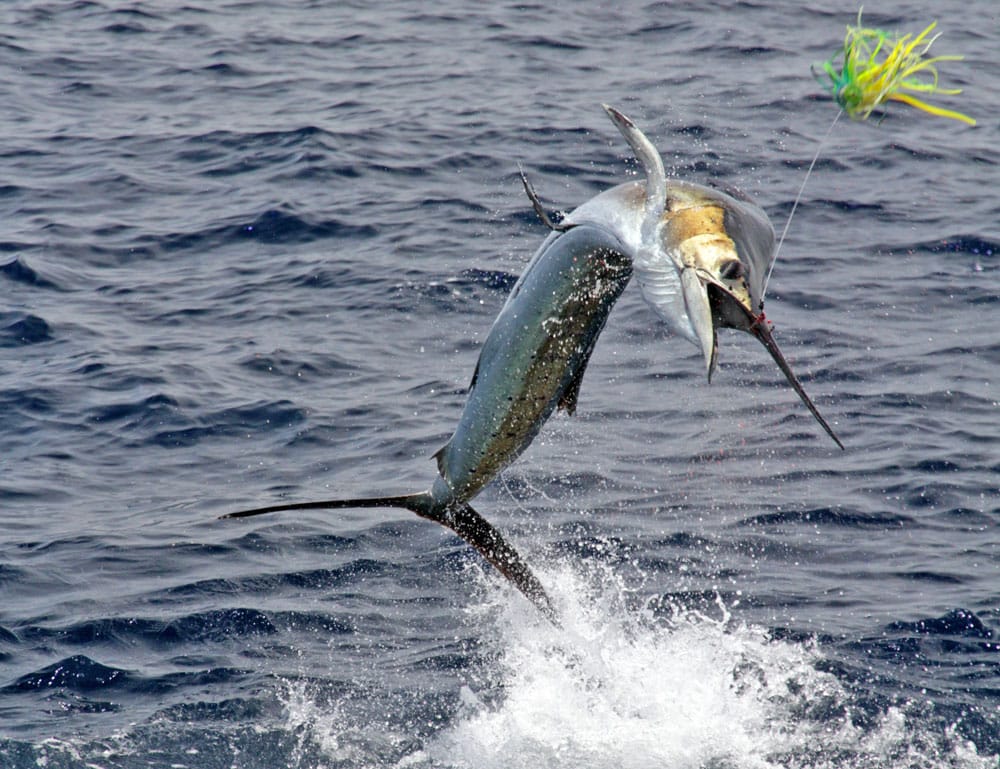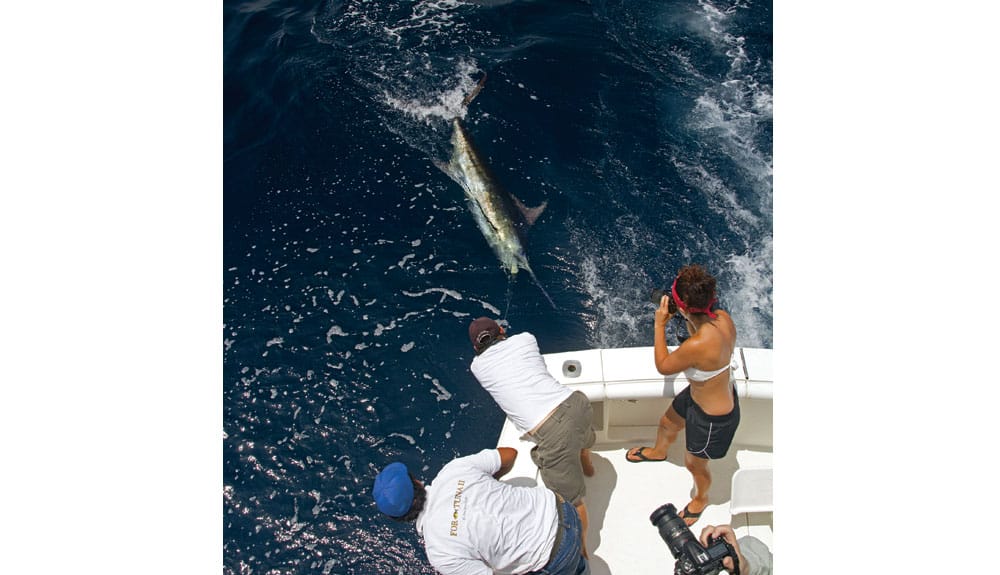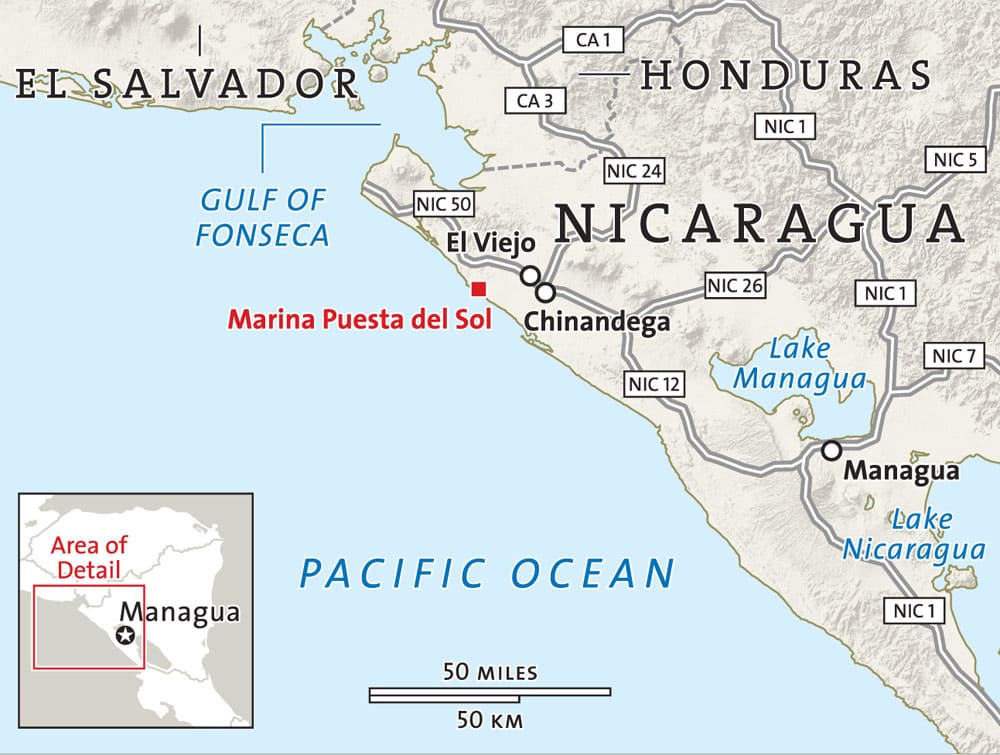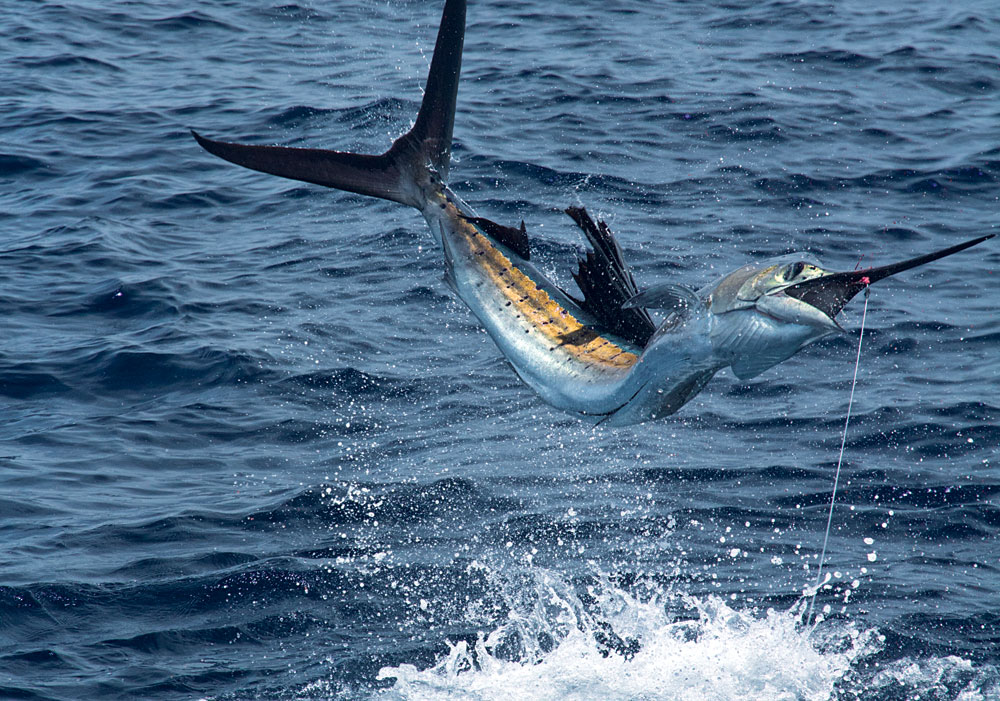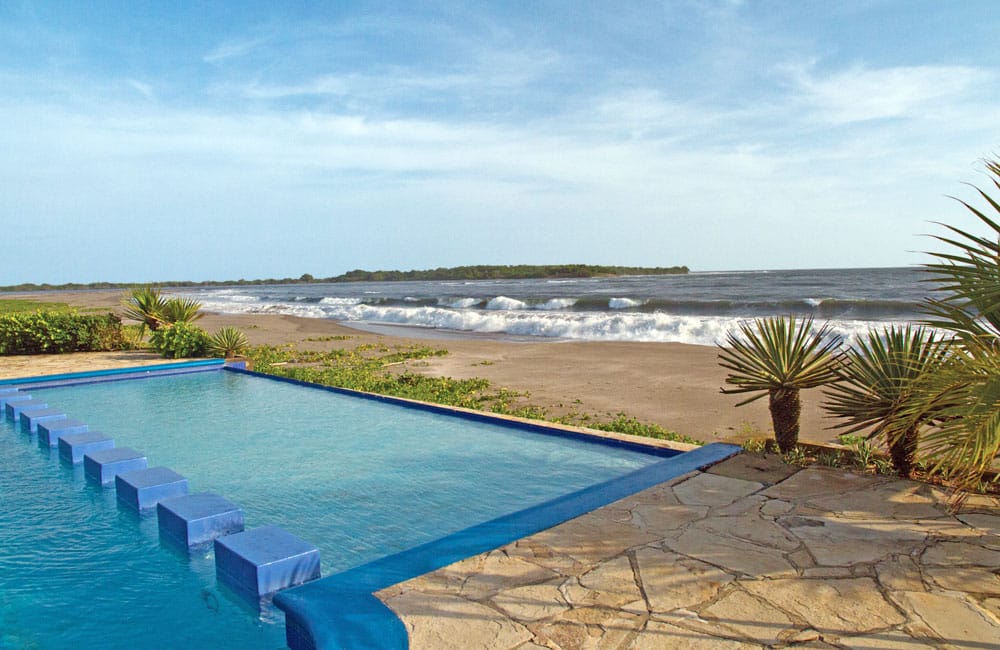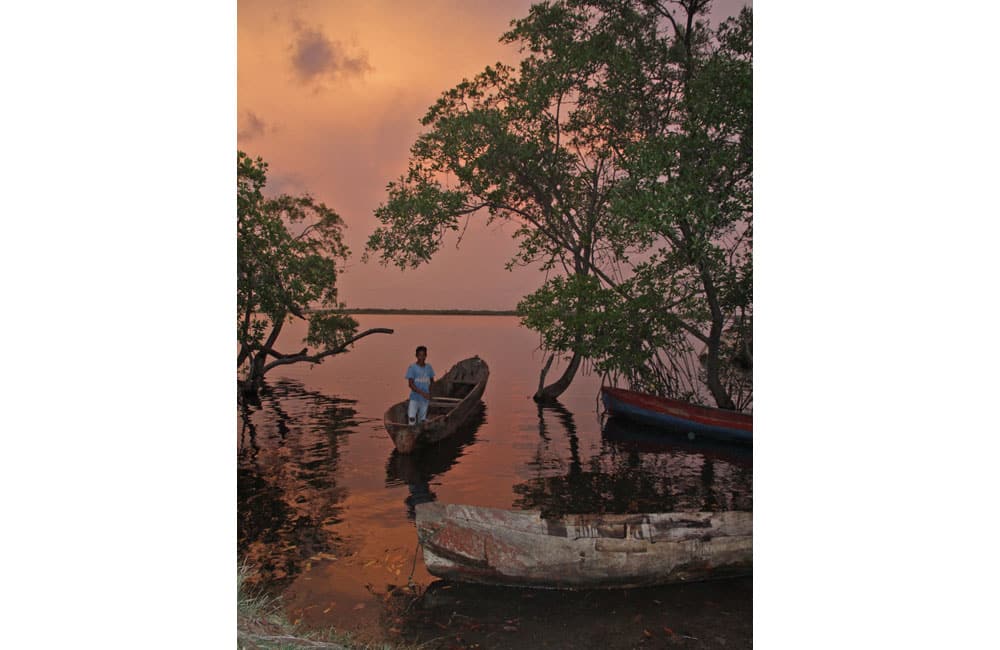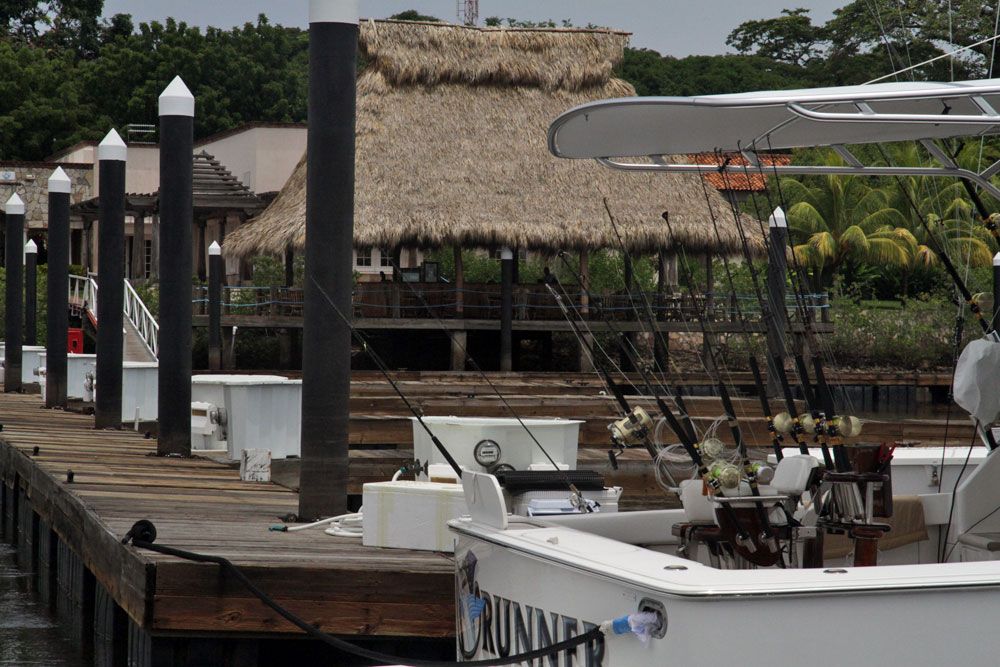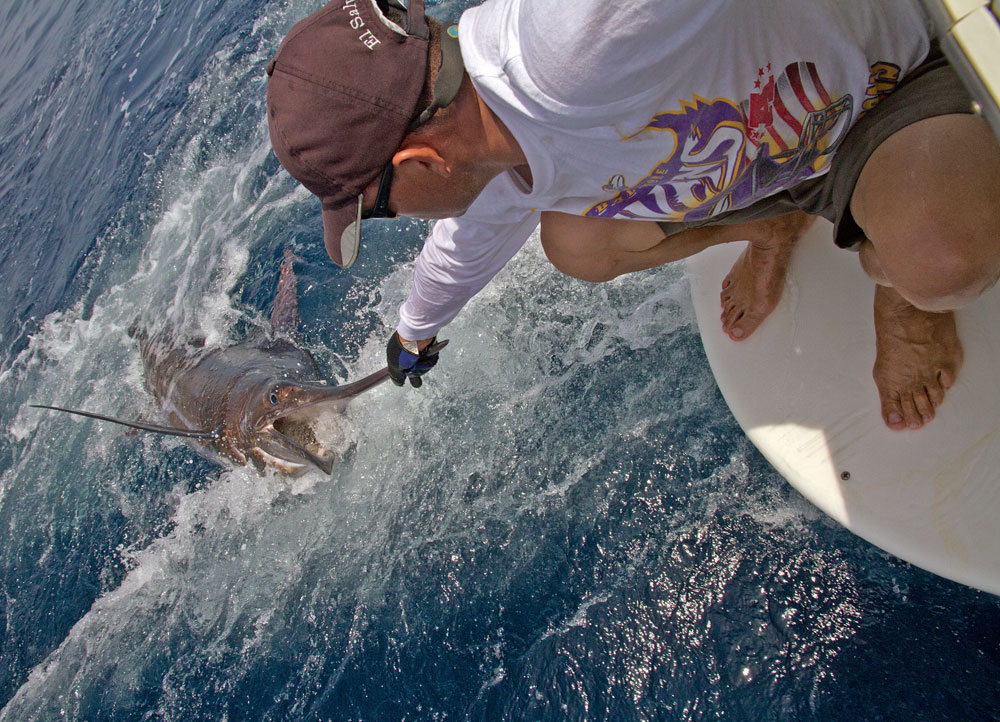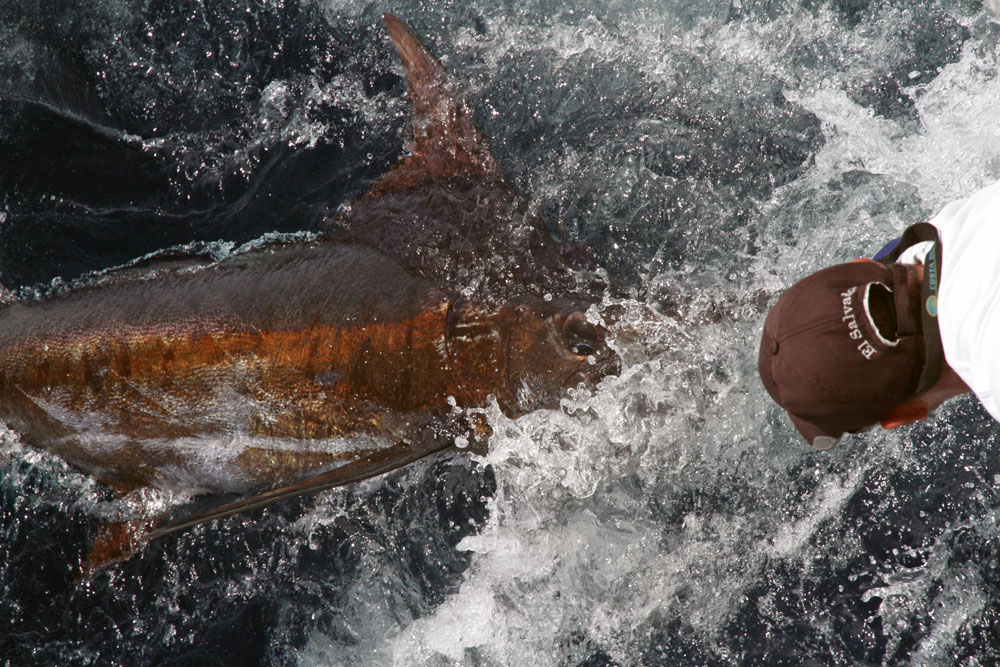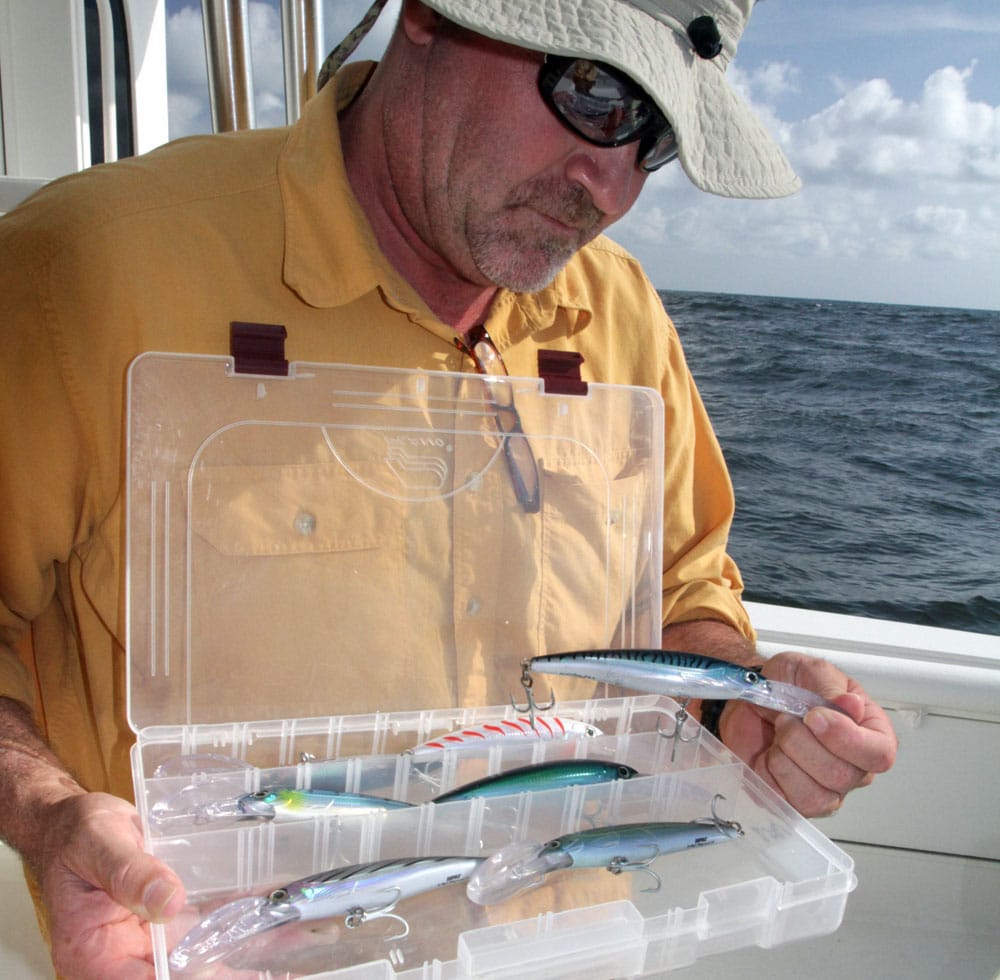The thrum of the engines fell to a murmur as we settled into trolling speed and the mates set the lures. We shifted around the cockpit, prepared for the waiting inherent to billfishing. Today it was not to be. We scarcely got comfortable before the first reel went off.
Bedlam ensued. Mates cleared lines, and anglers jockeyed for position and a spot in the chair as a black marlin in the 300-pound class greyhounded toward the horizon.
Forty minutes and three anglers later, we had the fish at the transom. Once he’d unhooked it, the mate carefully revived the exhausted fish, giving it a chance to return to full vigor before releasing his hold on the bill in the prop wash as we watched it glide toward the depths. It was a great start to the morning, and before it was over, it would bring a second black marlin and a Pacific sail boatside before the bite cooled in the early afternoon.
New Grounds
We were fishing about 40 miles offshore in the Pacific on the northern Nicaraguan coast. The gentle slope of the bottom drops off sharply into an encroaching canyon here, and that’s where we had put out the lures and found fish.
Unlike most billfish destinations, we had an entire patch of ocean to ourselves that day: both a blessing and a handicap. To the upside, any fish in the area were ours and ours alone, since we had no competition. On the other hand, we had a vast area in which to locate them and were totally without the shared information that often makes offshore fishing so much more productive. Captains are accustomed to fishing without company here. The sole exception is in August, when the Marina Puesta del Sol, which was hosting us, also hosts the Flor de Caña Tournament.
The waters we were fishing have scarcely been explored by peripatetic anglers. Though the fishing in Costa Rica, to the south, and Guatemala, two countries to the north, is thoroughly fished, this stretch of the Central American coast has gone largely unexploited, which is precisely why Roberto Membreño, owner of Marina Puesta del Sol, embarked on his resort-development project a decade ago.
Location, Location
The resort sits on 600 acres of reforested farmlands, along a protected deepwater estuary that’s just minutes by boat from the open Pacific. It’s ideally situated for reaching the offshore billfish grounds and accessible by any size fishing boat in almost all conditions, yet tucked away behind a protective point that keeps the waves and wind at bay.
The bottom heading offshore descends gradually for the first 30 miles or so first, interrupted by fingers of deep water that encroach on the continental slope from the major drop-off into the depths, which lies some 50 miles offshore.
Few anglers have explored these offshore grounds, but one of them is Joe Crawford, who captains Rum Runner, owned by Don Carlos Pellas, proprietor of Flor de Caña Rum and primary sponsor of the annual Flor de Caña tournament held in August every year.
First Rites
Rum Runner’s home port is Quepos, in nearby Costa Rica, but between fishing the tournament and transiting the waters between Costa Rica and Mexico as part of his regular circuit of the best Pacific fishing, Crawford has spent considerable time in Nicaraguan waters, and has been exploring and fishing it regularly since 2005.
“We fished there first in June and saw excellent fishing,” says Crawford. “There was so much life in the ocean that is was hard to describe.”
The next season, Crawford fished the area from August through September. “We averaged 17 bites a day — pretty much all sailfish — and the next year, during August, the sailfish bite was strong across the board for all the boats in the tournament as well.”
This past season, he says the fish were on the northwest-facing edge of the drop-offs, and there were a lot more marlin than in previous years. “This year, we were four-for-seven on marlin in three days — a mix of blacks and blues.”
Tournament records for the past couple of years indicate that the record number of marlin released is 10 for some 25 boats over three days of tournament fishing, with the fish evenly split between blacks and blues. In 2012, a 400-pounder won the tournament, but in past years, boats have tallied marlin from 550 to just under 800 pounds. Overall, the total billfish count during the tournament every year runs between 200 and 300 fish.
Discovery Awaits
It’s not as though billfish are the only draw here — but the fact is, there have not been a lot of boats fishing these waters for long enough to get it all figured out. Crawford says yellowfin tuna averaging 40 pounds are relatively abundant, and dolphin run about the same size.
Lance Moss, who owns a surfing resort to the south, has done some exploratory inshore fishing, and reports an abundance of snapper and grouper on the reefs, roosterfish along the beach and in the surf, and wahoo in the nearshore seamounts.
“We found a seamount covered up with wahoo while out in our 25-foot panga,” he reports. “We took 14 wahoo, with most over 40 pounds, and a few close to 80.”
The estuary on which Marina Puesta del Sol sits is virtually unexplored, but as with most mangrove habitat along the Pacific side of Central America, there are reports of big snook that both move in with the tide and are resident to the maze of mangrove creeks.
If the fishing didn’t offer enough, visiting anglers can also shoot doves on a nearby farm. It’s possible to fish offshore in the morning then return to the resort for a short helicopter hop for wing-shooting in the afternoon.
“This is a special place,” says Crawford. “Some of the best fishing days of my career have been here.”
After our second morning offshore — when we released two sails and another black marlin, and a few miles north Crawford released seven sailfish — I could well understand his point of view.
Tackle Box
Northwest Nicaragua is primarily a destination for sailfish and marlin. Tuna, dorado and wahoo — and a relatively unexplored fishery for swordfish — also await offshore; roosterfish, snapper and grouper haunt the inshore reefs and shorelines, and there’s an unexplored mangrove estuary. Marina Puesta del Sol’s offshore boat has Shimano 50- and 80-pound tackle and all the right rigs for offshore and coastal trolling. For inshore fishing, casting or fly-fishing, you’ll need to bring any gear you think you might need.
Rods: Inshore and surf tackle, plug rods and fly rods suitable for surf and estuary fishing.
Reels: Spin, plug and fly — per your preference for exploratory fishing.
Line: 8- to 20-pound-test mono; 40- to 60-pound braid for plug casting. Knottable cable for leaders.
Lures: Jigs, diving and floating plugs, plastics and all variety of casting baits are in order. Colors are up to you — nobody knows!
Planning Your Trip to Nicaragua
Marina Puesta del Sol is accessible by road from Managua. An airstrip should be in place at the resort by the end of the year, but to date there are no charter flights for anglers from Managua.
The resort is top-notch: Service and facilities are second to none, from the Wi-Fi-equipped rooms to the dockside bar, ample slip space and fuel docks. Well-equipped boats are available at the marina, with a 40-foot Ocean resident and others readily available. Outboard-rigged center consoles are available for inshore fishing.
Where: Northwestern Nicaragua, near Chinandega
When: Summer is best for offshore fishing, but these waters are productive year-round.
Who: Marina Puesta del Sol U.S. Office: Marc Membreño, 408-588-0017; in Nicaragua: 011-505-8883-0781;** info@marinaps.com**
